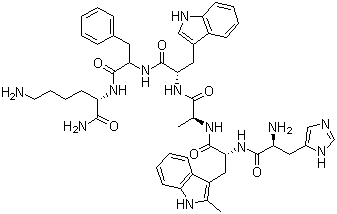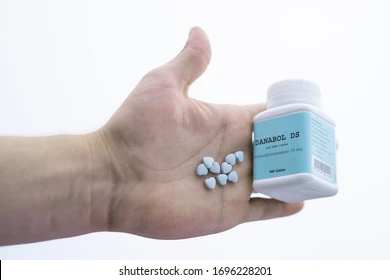Hexarelin
L-Histidyl-2-methyl-D-tryptophyl-L-alanyl-L-tryptophyl-D-phenylalanyl-L-lysinamide; Examorelin
| Molecular Formula | C47H58N12O6 | |
| Molecular Weight | 887.04 | |
| CAS Registry Number | 140703-51-1 | |
 Hexarelin is a six-amino acid peptide. Studies have shown that hexarelin is actually more effective and longer lasting than growth hormone releasing hormone (GHRH). It is also known that GHRP-6 has a synergistic effect with GHRH, causing a far greater release than either of these substances alone. By combining GHRP-6 with Hexarelin, a more potent GH releasing peptide combination is created than ever heard of. The potential clinical usefulness of these GH releasing hexapeptides is also reinforced by observations that long-term administration produces elevations in circulating IGF-1 concentrations. Long term treatment with GHRP-6 similarly has been shown to elevate serum IGF-1 as well as IGF-binding protein-3 concentrations and promote linear growth.
Hexarelin is a six-amino acid peptide. Studies have shown that hexarelin is actually more effective and longer lasting than growth hormone releasing hormone (GHRH). It is also known that GHRP-6 has a synergistic effect with GHRH, causing a far greater release than either of these substances alone. By combining GHRP-6 with Hexarelin, a more potent GH releasing peptide combination is created than ever heard of. The potential clinical usefulness of these GH releasing hexapeptides is also reinforced by observations that long-term administration produces elevations in circulating IGF-1 concentrations. Long term treatment with GHRP-6 similarly has been shown to elevate serum IGF-1 as well as IGF-binding protein-3 concentrations and promote linear growth.
Hexarelin: A Comprehensive Profile
Hexarelin is a synthetic peptide classified as a growth hormone-releasing peptide (GHRP). It functions by stimulating the pituitary gland to increase the production and release of growth hormone (GH), promoting various physiological benefits. As a potent and selective GHRP, Hexarelin is frequently utilized in research and therapeutic contexts for its ability to enhance recovery, muscle growth, and fat metabolism.
One of Hexarelin’s standout features is its capacity to stimulate GH secretion without significant interference with the body’s natural production rhythms. This makes it appealing for individuals seeking performance enhancement, accelerated recovery, or anti-aging benefits. Its effects include increased lean muscle mass, improved bone density, enhanced fat loss, and support for cardiac health.
While effective, Hexarelin can lead to mild side effects, such as water retention or joint discomfort, particularly at higher doses. Long-term use may also result in desensitization, reducing its efficacy over time. It is typically administered via subcutaneous injection, with dosages tailored to individual goals.
Due to its promising effects on muscle repair and metabolic function, Hexarelin remains a popular research compound in sports medicine and endocrinology, though it is not approved for widespread medical use.







